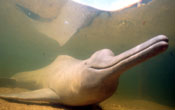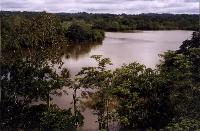PANACOCHA
PROTECTION
Ecuadorian Headwaters of the Amazon
 |
 |
|
| Amazon River
Dolphin copyright Greg Ochocki |
Slide Show here |
Daniel Sussot's article 7/02 journal excerpts by Ruth Rosenhek 9/98
WHY THE AMAZON?
With 2,700 bird species and more than 2,000 different types of fish, the Amazon is one of the most biologically diverse areas in the world, and also one of the most threatened. Cattle ranches, gold mining and soy plantations are rapidly replacing the dense tropical forest at an estimated rate of about eight football fields per minute or 5,300 hectares a day, according to Steven Schwartzman, a senior scientist with the Environmental Defense Fund.
The Ecuadorian Amazon, thirty percent of which is presently open to oil activities, is home to 95,000 indigenous people comprised of 8 distinct cultures. The Amazon snakes and swivels thousands of miles and draws in water from over 1500 sources, including the Rio Napo in Ecuador, one of its primary tributaries. Whatever happens here in the headwaters effects the river for thousands of miles to its mouth. This is one reason why we, the Rainforest Information Centre in Australia, have become so interested in protecting the Panacocha reserve from oil drilling, logging, poaching, colonization and other threats.
The Panacocha Bosques Protectores (Protected Forest) is 56,000 hectares of primary rainforest, home to jaguars and ocelots, 9 species of monkeys, 500 species of birds and many more. It includes a network of waterways including the spectacular Panacocha Lagoon where the endangered Amazon River Dolphin lives. Panacocha is located in the narrow gap between Ecuador's two largest protected areas in the Amazon providing a wildlife corridor between the 982,000-hectare Yasuni National Park and the 600,000-hectare Cuyabeno Wildlife Reserve.
By strengthening protection for Panacocha, we are helping to establish a huge (more than 1.6 million hectares) contiguous park in the headwaters of the Amazon. Unfortunately, in Ecuador, protection status does not by itself stop colonization, logging, poaching or mineral extraction. Cuyabeno has been impacted by oil drilling in the past and Yasuni has a large number of active oil wells. While Panacocha is so far free of oil drilling, the threat of the petroleum companies is imminent. Occidental Petroleum has moved into the region and began employing members of the community during this past year. To maximize protection, we need to establish a management plan for the Reserve and create alternative economic opportunities for local peoplee.
The Rainforest Information Centre and Ecuadorian partner, the Centro de Investigacion de los Bosques Tropicales (CIBT), have been active in protecting Panacocha since the early '90's and in 1994 they succeeded in having the area granted "Bosques Protectores" status.
In 1998, Rainforest Information Centre recruited a coalition of groups to further the protection of the region. Member groups are: Ancient Forests International (US), Centro de Investigaciones de Bosques Tropicales (CIBT, Ecuador), Earthways Foundation (US) Rainforest Concern (UK) and Rainforest Information Centre (RIC, Australia).
The project entails several components including a Management Plan, Eco-Tourism enterprise and work with the local community.
MANAGEMENT PLAN
In 1994, CIBT was entrusted by the Ecuadorean government with the responsibility of elaborating the Management Plan for the area. A first draft was submitted in 1996 when the expense of surveying the area, creating maps, species inventories and community consultations brought things to a pause. Recent colonization pressures, tourism, oil exploration, and outstanding land tenure issues demand that the Management Plan be completed and approved as soon as possible in order to begin implementing sound conservation policy in the region. CIBT was once again entrusted by the government with this task and the international Panacocha coalition raised the approximately US$80,000 cost and work on this is nearing completion
A successful Management Plan will help retain habitat connectivity among more than 1.5 million hectares in the Ecuadorian Oriente by allowing the project to maintain critical momentum and to protect the quality of life for many species, including human residents.
ECO-TOURISM
In 1999, one of only two areas of freehold land within the Panacocha Reserve was offered for sale, a 50 hectare ecotourist resort with 8 thatched cabins and tree tower viewing platform on the banks of the Panacocha Lagoon. After 18 months fundraising, our coalition of environmental groups purchased Cabañas Pañacocha to express our commitment to the area, monitor wildlife and human activities, and illustrate a conservation model to both the surrounding communities and visitors. Pañacocha is more remote than the popular Sacha and La Selva lodges, being several hours farther down the Rio Napo. As a result, wildlife habitat and populations are proportionally more intact. For example, two freshwater dolphin species use the river and lagoons and nine primate species still inhabit the reserve.
Hunting pressures are real. We have begun developing comprehensive species lists and we are also helping to halt illegal colonist invasions. To facilitate community outreach and turn the focus of the lodge away from profit, we are forming an Ecuadorian non-governmental organization, Fundación Pañacocha, that will own the lodge and implement conservation and education programs.
UPDATE JUNE 04 A Contract has been signed leasing the Panacocha Lodge to a Quito university. They will be rebuilding the lodge and organising events there.